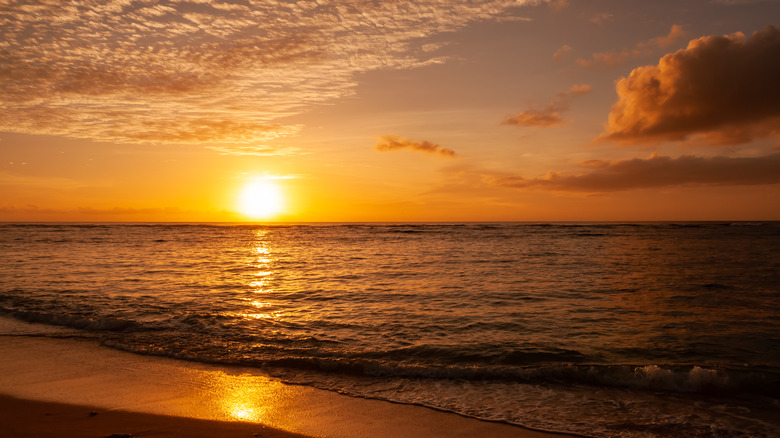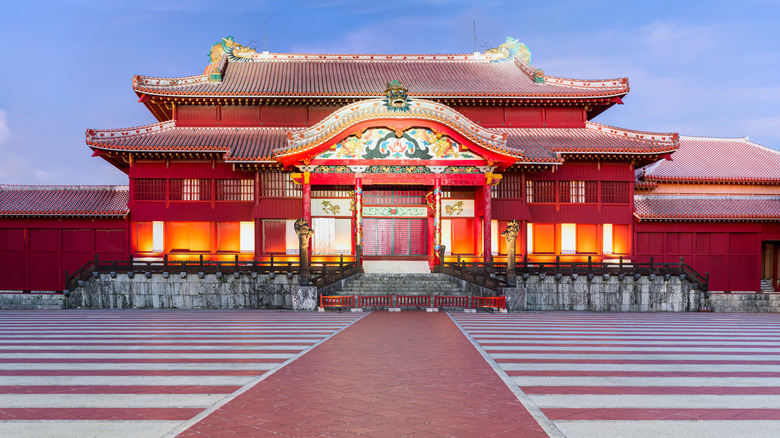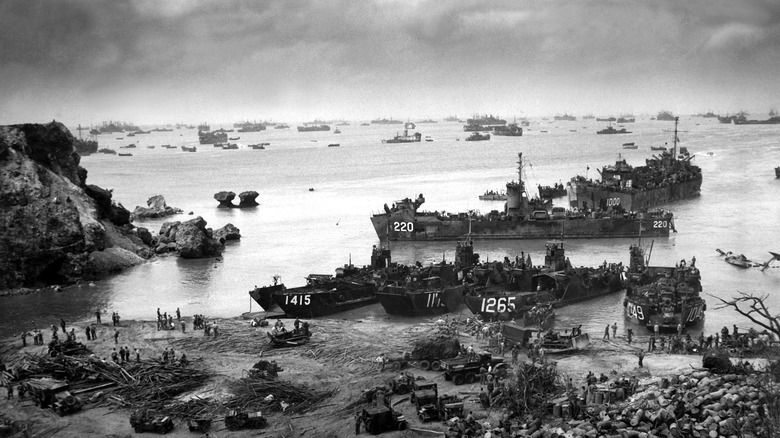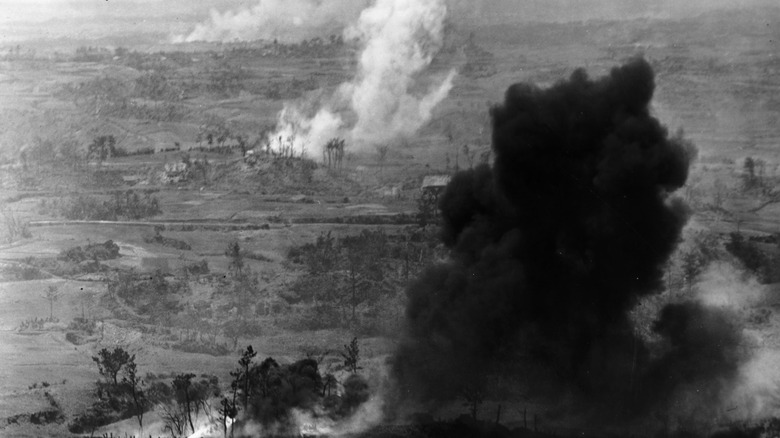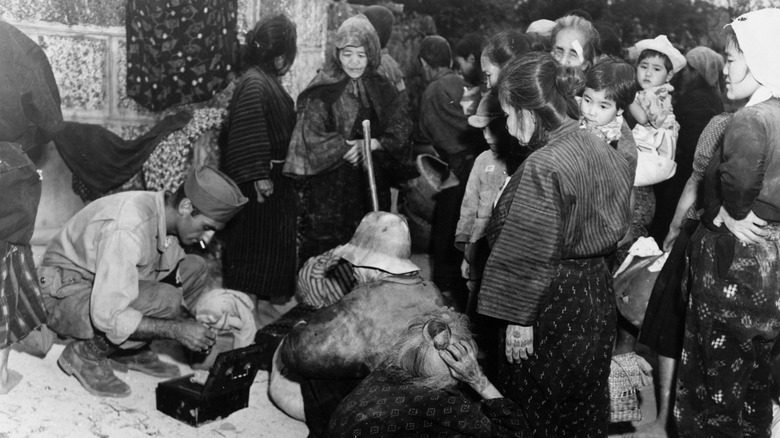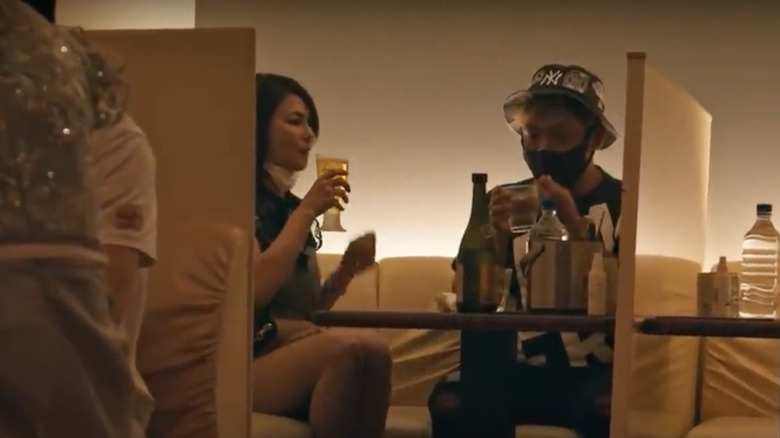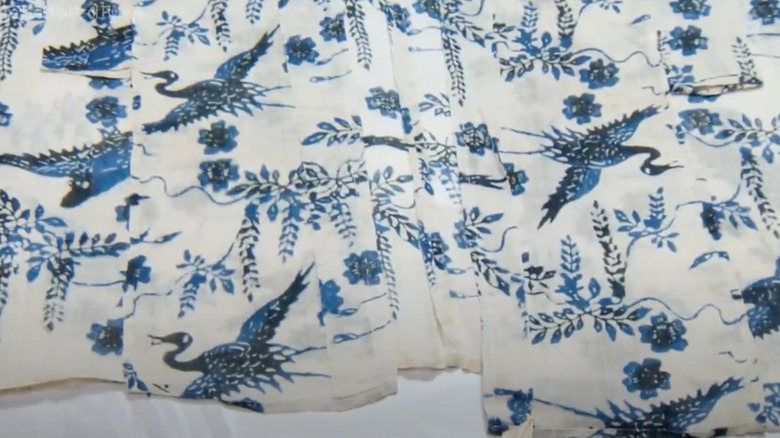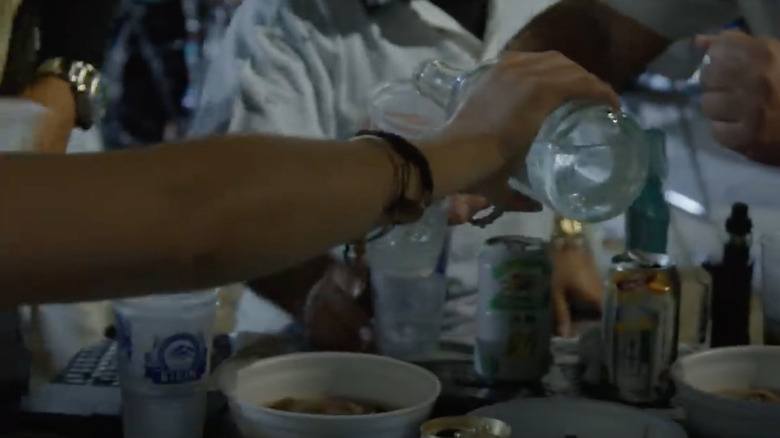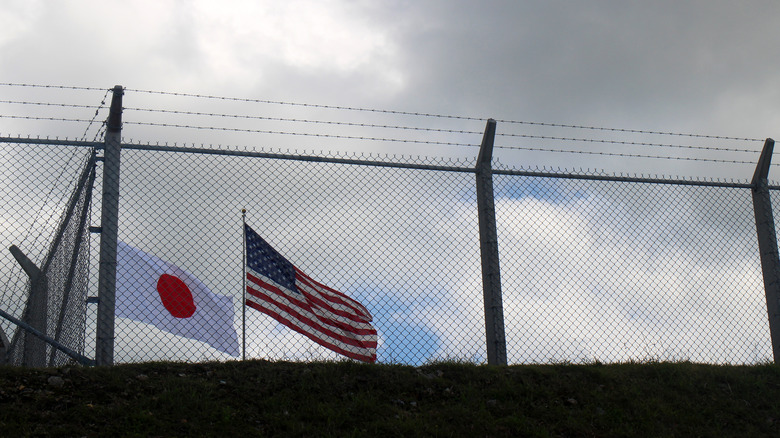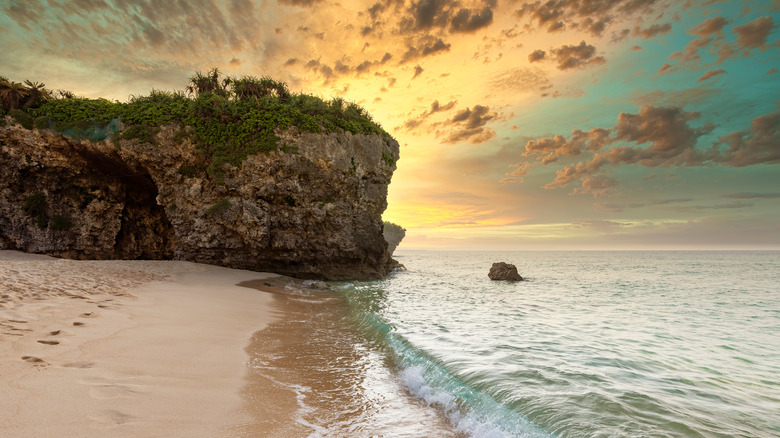The Tragic History Of Okinawa
Warning: this article contains references to violence, suicide, substance abuse and sexual abuse and exploitation.
Okinawa might be the Eden of the Pacific. Sparkling seas beckon tourists to the lush, tropical islands scattered off the southern coast of Japan, but there has been — and still is — trouble in paradise. If you look past the shade of gently swaying palm trees, Okinawa's past casts longer and darker shadows. It was once its own kingdom that rose and fell and literally burned to the ground more than once. During the last days of World War II, the bombing and shooting and shelling on Okinawa Island took hundreds of thousands of lives, with soldiers hiding in caves and civilians often caught in the crossfire. The economy then plummeted and poverty levels rose. Some ancient traditions and cultural treasures nearly went extinct.
Okinawa is still plagued by poverty. Unemployment rates skyrocketed when the COVID-19 pandemic held off tourism. Many single mothers find they have no choice but to turn to sex work as their night job if they want to support their families. Other women are raped by servicemen living on one of the many military bases. Those bases have also experienced dangerous accidents and leaked massive amounts of toxins into the drinking water. Alcoholism is also more prevalent among Okinawans than in mainland Japan. Sometimes, the intoxicated will fall asleep on the road, and there have been fatalities.
Though it has been through horrors, Okinawa continues to prevail, but not without trauma.
There was once a lavish kingdom that has long since vanished
What is now known as Okinawa Prefecture is a handful of islands known as the Ryukyu Islands. These islands flourished under the Ryukyu Kingdom until the 17th century, according to the Okinawa Peace Network of Los Angeles, whose capital was the grandiose Shuri Castle on Okinawa Island.
Within the kingdom blossomed a unique culture. There were limited interactions with Japan, but the Ryukyus showed loyalty to China from the 14th century onward, through trade and integration of some Chinese cultural aspects into their own. Ryukyu was taken over by the Satsuma-han of Japan in 1609 who seized some of its islands to the north, the Amami Islands (now part of Kagoshima Prefecture as opposed to Okinawa Prefecture), and took advantage of the sugarcane industry, forcing locals into grueling labor. This period became known as "Sato jigoku" which translates to "Sugar hell."
Satsuma rule allowed the rest of the kingdom to remain somewhat sovereign — but it only appeared that way because the ruling dynasty was not dismantled. The Japanese had ulterior motives. Under the guise of a sovereign Ryukyu Kingdom, they could use the islands as a gateway to trade with China without any suspicion, even though trade between Japan and China had long since ceased. The kingdom was finally integrated into Japan during the Meiji Restoration of 1868. Because of the integration of Japanese culture, The Ministry of Foreign Affairs of Japan calls that period a cultural renaissance.
Shuri Castle stood for hundreds of years until it burned down
Shurijo Castle, also known as Shuri Castle, was first built in 1730. This national treasure continued to stand even after the Ryukyus were taken over by the Satsumas of Japan.
The castle would eventually fall. According to the BBC, it had already burned down three times during the Ryukyu dynasty, because it doesn't take much to ignite wood and lacquer. It was first assaulted by an air raid during World War II, according to Japanese newspaper The Mainichi, going up in smoke as U.S. fighter planes dropped bomb after bomb on what was once the heart of Okinawa's ancient Ryukyu Kingdom. It was attacked after American forces found out that high-ranking members of the Japanese military were using its basement as shelter, then rebuilt after American occupation of Okinawa ended in 1972. Japan felt it owed this to the battleground where so many soldiers and civilians had perished.
Though the castle had been decaying, it was repaired to its former glory. The problem is that it caught fire from much less than a shower of missiles. In 2019, a fire of unknown origins engulfed all seven buildings of the reconstructed Shuri Castle within about eleven hours, as the BBC reported, and a fresh coat of lacquer only enraged the persistent burning. It had been razed to the ground by the time the last flames were extinguished, with only its stone walls remaining. Restoration efforts are now underway.
The Battle of Okinawa took hundreds of thousands of lives
The carnage on Okinawa during World War II became infamous as the bloodiest battle on the Pacific front of World War II, as Smithsonian Magazine remembers.
What ended up being a literal fight to the death was triggered because the U.S. wanted to capture Okinawa and use it a base to launch bombs at the enemy. It was a strategic plan to set the Axis Powers back by bombing their industrial sites, but at the cost of hundreds of thousands of lives. Japan lost 110,000 soldiers and 100,000 civilians, while 12,000 Americans were sacrificed. According to the NHK World News Japan documentary "Civilians in the Crossfire: The Battle of Okinawa," it was within a month that half of those civilian lives were lost. Former military pilot Philip Wilmot still remembers the horrors he saw. "We were never told to shoot at civilians," he said. "But you don't know who's who, it's just that if anything moves, you shoot it."
Japanese forces were willing to take any risk to eliminate the opposition and defend their battleground. Kamikaze attacks and guerrilla warfare were already wiping out the Americans, and Japanese military officials believed that extending this combat was necessary — they needed more time if they planned to soon fight a mainland battle and succeed. American forces fought back with VT fuses that exploded before hitting their targets. These may have brought down kamikaze planes, but they also killed civilians in massive showers of shrapnel.
Fighting was so brutal that soldiers and civilians hid in caves
Because there was so much shrapnel raining down on Okinawa, both soldiers and civilians sought refuge in underground caves. Hiding in caves could be just as brutal as being caught in the bombardment above, though. Smithsonian Magazine says that opposing forces ended up using flamethrowers against soldiers who crawled into caves instead of surrendering, and that those caves would then be flooded with the smell of burning flesh. The Japanese would strike back by conducting guerrilla warfare from the caves, hiding and then striking when it was least expected, as "Civilians in the Crossfire" reveals. Former Japanese private Morii Naojiro was one of those soldiers.
"We were 'human bullets,'" he told NHK World News Japan in the documentary. "We used hand grenades ... We each got two [and] they were heavy. One was for you. One for the enemy. None of us expected to survive."
Many civilians who sought refuge hid below with the soldiers. They often found themselves trapped and unable to flee. For the soldiers, receiving supplies and reinforcements was nearly impossible, and they would be ordered to launch suicide attacks, and civilians would perish in the fallout. It sometimes became too much. Civilian groups would commit shudan jiketsu — mass suicide — when it seemed they had no chance at breaking out. In a report, one unnamed American soldier wrote that he suddenly heard a tremendous blast that left behind "ten shattered bodies," among which there were women and children.
If you or anyone you know is having suicidal thoughts, please call the National Suicide Prevention Lifeline by dialing 988 or by calling 1-800-273-TALK (8255).
Anyone who survived the war had to face economic destruction
For the survivors of the war, life remained a battle. Okinawa's postwar economy plummeted so far that it struggled to catch up with mainland Japan, according to Japanese news site Nippon.com.
Okinawa is still trying to reach "hondo nami" (an economic status that would be "on par with the mainland") since its 1972 return to Japan by the U.S., which had taken control of it for 27 years after the end of World War II. It was only a year before that when the Nixon administration decided the U.S. dollar would no longer be convertible into gold. The dollar was the currency still used in Okinawa at that point. As a result, the yen rose in value as the dollar sank, and imports from mainland Japan became difficult to afford since the dollar could not stretch too far.
The gaping difference between strength of the mainland economy versus the weakness of the Okinawan economy made the islands more difficult to integrate into Japan. Okinawa would have to be forced to convert to the yen if it was to make any progress, but extreme inflation made that nearly impossible. Too much would be lost when dollars were exchanged for yen. The economic tension between Okinawa and the mainland would remain a burden. As The Japan Times admits, even half a century after Okinawa was returned to Japan, the prefecture struggles to catch up when it comes to income and welfare.
Poverty is staggeringly high and often pressures women into sex work
Triggered by the ravages of World War II along with inflation and the 1973 oil crisis that saw staggeringly high unemployment rates, Okinawa now has the highest poverty rate in Japan, according to Vice.
Poverty is startlingly common among single Japanese parents. The plight of single Okinawan mothers — 87% of which have to shoulder single-parent households — is often having to raise children and work long hours. This has also doubled child poverty rates compared to mainland Japan. More often than not, because of the prefecture's high divorce rate, mothers who suddenly find themselves raising their children alone have to resort to sex work for extra money. It has come to the point that women who are recently divorced or about to be divorced know who to ask in order to secure a second job that will keep them and their children afloat.
Most single mothers who need to turn to the sex trade work as club hostesses. In Japan, a hostess is not just someone who greets you at the door of a restaurant, but who is paid to entertain wealthy men, as an undercover reporter for The Telegraph (via Business Insider) found out. Hostesses are not actually required to have sex with customers. But the shady underside of this business is that those who receive a special request to pour drinks, sing karaoke, and otherwise keep patrons occupied through the night are often expected to go home with one.
Some ancient artistic traditions are close to being forever lost
Ton-byan is an elusive textile that was an enigma for centuries. In the documentary "The Lost Textile of Ryukyu," NHK World News Japan investigates the mysterious origins of ton-byan.
What made the material that went into ton-byan so difficult to figure out was its ethereal translucence, something not seen in other fabrics that were common among the elite of the Ryukyu Kingdom. This is where the history of Ryukyu trade with China comes in. What it turned out to be was a rare type of Chinese ramie, whose translucent threads gave it that otherworldly glow. It has only been reproduced once.
Basho-fu is another textile whose production almost ceased after the devastating aftermath of the war, according to Google Arts and Culture. It once used to be worn by the samurai of the Ryukyu kingdom and is now being resurrected. Papier-mache Ryukyu hariko figurines are also almost becoming a thing of the past. The ancient Okinawan tattoo art of hajichi, which had been created for women of power by other women, nearly vanished until it recently experienced a revival, according to The Washington Post. Hajichi tattoos on hands and arms used to be rites of passage. They arose as symbols of womanhood, beauty, marriage, and protection from evil spirits.
Alcoholism plagues the islands
The effects of poverty in Okinawa reach far beyond desperation for work. As Vice found out, poverty is thought to have influenced alcohol consumption in the prefecture, which is high enough to put people at risk for severe diseases, including cirrhosis, and even death.
The phenomenon of "rojo-ne" or "road sleeping" has only made things worse, according to The Mainichi (via The Guardian). Intoxicated people will literally pass out on the road — sometimes dangerously close to passing cars. Okinawan police think that awamori (a locally distilled rice liquor) is often to blame. In study published in Japanese Rural Medicine, researchers found that death from liver disease is twice as likely in Okinawa Prefecture than it is anywhere else in Japan. They also believe that there may be higher levels of alcoholism on the remote islands off the coast of Okinawa Island.
Alcoholism and intoxication-related deaths among Okinawans hit a dangerous high in 2017 after a spike in fatal cases of liver disease that was caused by alcohol. Teruyuki, an Okinawan local, told Vice that he became an alcoholic after patrons at the bar where he used to work kept goading him to drink. He developed an addiction that lasted decades and eventually left him without a job or a home, but it didn't stop there. "I stole alcohol to keep drinking, and was sent to prison for that," he said. "I've been in and out of prison five times now."
If you or anyone you know is struggling with addiction issues, help is available. Visit the Substance Abuse and Mental Health Services Administration website or contact SAMHSA's National Helpline at 1-800-662-HELP (4357).
Okinawans are literally being poisoned by military bases
Military bases, most of them American, have been a persistent problem on Okinawa since World War II. They are plagued with everything from water contamination to sexual abuse.
Okinawa and mainland Japan continue to have disagreements over whether it should shoulder this burden, as The Diplomat observes. The 31 bases on the islands make up 70% of all military bases in Japan. Most Okinawans want the land returned to the islands, but the Japanese government insists that the bases are necessary to keep its alliance with the U.S. intact. Holding on to them has led to sometimes-fatal accidents such as a nuclear rocket randomly going off, a hydrogen bomb falling into the ocean, a nerve gas leak, and, as The Diplomat reveals in another article, an influx of chemicals from firefighting foams.
Toxic chemicals known as PFAs (polyfluoroalyl substances) also threaten people's health when released into the drinking water. These can cause several types of cancers, raise cholesterol, and even make a patient less likely to respond to vaccines. Kadena Air Base is one of the worst offenders, and at Futenma Air Station, 140,000 liters of PFA foam that recently spilled after a barbecue ended up switching on the sprinkler at one of the hangars. It stayed that way until Japanese officials were allowed to inspect the scene. On top of that, PFA limits are not regulated in Japan, according to The Asia-Pacific Journal, so Okinawans continue to fight for an end to chemical pollution.
Many Okinawan women are threatened by prejudice and sexual abuse
While many Okinawans have embraced some aspects of American culture long after the prefecture was handed back to Japan, others who try to blend in often deal with negative stereotypes. That isn't the only thing they have had to endure.
"Amejo" first arose as derogatory slang for women who associated with American G.I.s., as revealed by the Vice documentary "Japan's Stereotypes Against Amejo in Okinawa." They are often thought of as easy party girls. But underneath the gossip and assumptions are actually young women who are only trying to be themselves, and part of their personal identity merges Japanese traditions with American style and music into something uniquely Okinawan. Nanoki, a singer, remembers first hearing "Amejo" when she was a preteen. "I told my mom I wanted to be an Amejo and she scolded me for it," Nanoki remembers.
There is a dark side to so many U.S. servicemen from abroad being stationed in Okinawa. TIME Magazine reports that one Air Force staff sergeant allegedly raped a local woman, and two more military men admitted they chose that base because they wanted to be around a bevy of beautiful women. More recently, according to NHK (via Vice), a Marine admitted to pulling a woman out of her car and raping her in a parking lot while he was intoxicated. The crime fueled resentment and protests. Unfortunately, there have been many more accounts of similar incidents across Okinawa.
If you or anyone you know has been a victim of sexual assault, help is available. Visit the Rape, Abuse & Incest National Network website or contact RAINN's National Helpline at 1-800-656-HOPE (4673).
Tourism is Okinawa's main industry — but it was almost swallowed by the pandemic
The economic effects of COVID-19 hit Okinawa especially hard. The islands run on tourism, but with travel shutting down everywhere, their main income source almost vanished. Poverty already runs rampant in Okinawa, and the 80% drop in tourists during 2020, as Japan Times reports, almost ruined its already-fragile economy. Tourism is fueled by whatever gets you to your destination (airlines), where you stay (hotels), the places you visit (sites such as Shuri Castle before it burned down), and shops that sell everything from sunblock to souvenirs. And his was back when there was still no vaccine and international travel had become virtually nonexistent. Restaurants also suffered, especially those in areas that usually experienced heavy tourist traffic.
Unemployment rates in Okinawa during the height of the pandemic were almost twice what they were in mainland Japan. The only other things keeping Okinawa going then were public works and military bases, according to The Japan Times. While the local government would rather not admit military bases were an assist, since they have also been a source of crime and destruction, they did make a difference.
This isn't the first time Okinawa suffered a massive economic downturn, as The Asahi Shimbun notes. Both the events of 9/11 and The Great East Japan Earthquake of 2011 almost put a freeze on tourism. As the waters open up again, Okinawa will once again welcome tourists to its shores.
